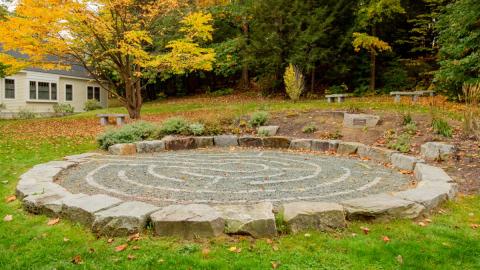
The Plymouth State University Peace Garden has been a little gem of calm and quiet on a busy campus since September 2016. It features a 5-circuit labyrinth and was designed and built by Jamie McMillan ’08. It also includes benches for relaxing and meditating. One bench proclaims “May peace prevail” and is dedicated to Professor James Hogan and his wife, Nancy Hogan. Professor Hogan was the founder of Plymouth State’s Model United Nations program and taught for 33 years on the Social Science faculty.
A ginkgo biloba tree graces the garden, planted on Arbor Day 2012. The ginkgo is an ancient, Asian symbol of peace and hope. Four ginkgos survived the atomic blast in Hiroshima in 1945 and continue to thrive to this day.
Leo Sandy, professor emeritus of counselor education and school psychology, and Scott Meyer, professor emeritus of social work, proposed the Peace Garden. They were co-chairs of the Culture of Peace Task Force, which became the Peace & Social Justice Studies Council. Kathy Tardif, Catholic Campus Minister and member of the P & SJS Council, added a labyrinth to the plan.
PSU’s Peace Garden and Labyrinth are located next to the Counseling Center.

What is a Labyrinth?
A labyrinth is an ancient spiritual tool, a resource for personal discovery and growth. A popular use of a labyrinth is for walking meditation. Labyrinths also allow people to embark on a journey of self-discovery and healing.
Labyrinths have been used around the world for over 3,500 years. Walking the labyrinth provides an opportunity to reflect, think critically about a question or problem, connect with your physical self, reduce stress, experience gratitude, inspire creativity, or grieve.
Often confused with a maze, which is a puzzle to be solved, a labyrinth is a path to be followed. It is a winding path moving in turns toward a center point for reflection. The path is unicursal, meaning the ways in and out of the labyrinth are the same.
Suggestions for Walking a Labyrinth
There are many ways to walk a labyrinth. These suggestions can help get you started.
- Before entering a labyrinth, pause and center yourself. Decide the intention for your walk. Then acknowledge the sacredness of the space with a bow, nod, or other gesture you feel comfortable making.
- As you walk the path, be aware of the experience. Be open to your thoughts and feelings.
- Before entering a labyrinth, pause and center yourself. Decide the intention for your walk. Then acknowledge the sacredness of the space with a bow, nod, or other gesture you feel comfortable making.
- As you walk the path, be aware of the experience. Be open to your thoughts and feelings.
- Walk often to get the optimal benefits for discernment of life choices, self-awareness, focus, and healing.
The Threefold Path
One particular way of walking a labyrinth is called the Threefold Path. Before entering the labyrinth, think of a concern or issue you have.
- Purgation (Releasing) – As you enter the labyrinth, let go of the concern or issue. Just walk.
- Illumination (Receiving) – In the center of the labyrinth, be open and prepared to receive whatever insight, clarity, or spiritual gift is there for you. Don’t worry if nothing appears to happen in the center. Simply be open.
- Union (Integrating) – As you leave the center and follow the path out of the labyrinth, if you received anything in the center, take ownership and responsibility for it. Without forcing anything, ponder how what you received can empower you in your life.
If nothing appeared to happen in the center, simply remain open. -
As you exit the labyrinth, check to see if you have received anything from your time there – perhaps calm, acceptance, or clarity about the concern or issue. You may have even received an insight or resolution. Sometimes, you don’t notice anything until a few days later.

